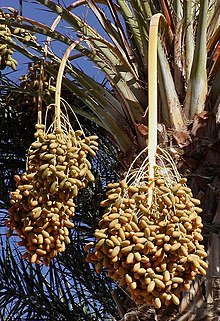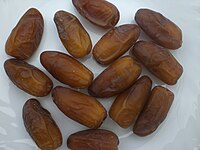Date palm
| Date palm | |
|---|---|
 |
|
| Dates on date palm | |
| Scientific classification | |
| Kingdom: | Plantae |
| (unranked): | Angiosperms |
| (unranked): | Monocots |
| (unranked): | Commelinids |
| Order: | Arecales |
| Family: | Arecaceae |
| Genus: | Phoenix |
| Species: | P. dactylifera |
| Binomial name | |
|
Phoenix dactylifera L. |
|
| Synonyms | |
|
|
|
Deglet Noor dates
|
|
| Nutritional value per 100 g (3.5 oz) | |
|---|---|
| Energy | 1,178 kJ (282 kcal) |
|
75.03 g
|
|
| Sugars | 63.35 g |
| Dietary fiber | 8 g |
|
0.39 g
|
|
|
2.45 g
|
|
| Vitamins | |
| Vitamin A equiv. |
(0%)
6 μg75 μg
|
| Vitamin A | 10 IU |
| Thiamine (B1) |
(5%)
0.052 mg |
| Riboflavin (B2) |
(6%)
0.066 mg |
| Niacin (B3) |
(8%)
1.274 mg |
| Pantothenic acid (B5) |
(12%)
0.589 mg |
| Vitamin B6 |
(13%)
0.165 mg |
| Folate (B9) |
(5%)
19 μg |
| Vitamin C |
(0%)
0.4 mg |
| Vitamin E |
(0%)
0.05 mg |
| Vitamin K |
(3%)
2.7 μg |
| Minerals | |
| Calcium |
(4%)
39 mg |
| Iron |
(8%)
1.02 mg |
| Magnesium |
(12%)
43 mg |
| Manganese |
(12%)
0.262 mg |
| Phosphorus |
(9%)
62 mg |
| Potassium |
(14%)
656 mg |
| Sodium |
(0%)
2 mg |
| Zinc |
(3%)
0.29 mg |
| Other constituents | |
| Water | 20.53 g |
|
|
|
|
|
| Percentages are roughly approximated using US recommendations for adults. Source: USDA Nutrient Database |
|
Phoenix dactylifera, commonly known as date or date palm, is a flowering plant species in the palm family, Arecaceae, cultivated for its edible sweet fruit. Although its place of origin is unknown because of long cultivation, it probably originated from lands around Iraq. The species is widely cultivated and is naturalized in many tropical and subtropical regions worldwide.
Date trees typically reach about 21–23 metres (69–75 ft) in height, growing singly or forming a clump with several stems from a single root system. The leaves are 4–6 metres (13–20 ft) long, with spines on the petiole, and pinnate, with about 150 leaflets. The leaflets are 30 cm (12 in) long and 2 cm (0.79 in) wide. The full span of the crown ranges from 6–10 m (20–33 ft).
The species name dactylifera "date-bearing" comes from the Greek words daktylos (δάκτυλος), which means "date" (also "finger"), and fero (φέρω), which means "I bear".
Dates have been a staple food of the Middle East and the Indus Valley for thousands of years. There is archaeological evidence of date cultivation in eastern Arabia in 6000 BCE. (Alvarez-Mon 2006). They are believed to have originated around what is now Iraq, and have been cultivated since ancient times from Mesopotamia to prehistoric Egypt, possibly as early as 4000 BCE. The Ancient Egyptians used the fruits to make date wine, and ate them at harvest.
There is also archeological evidence of date cultivation in Mehrgarh around 7000 BCE, a Neolithic civilization in what is now western Pakistan. Evidence of cultivation is continually found throughout later civilizations in the Indus Valley, including the Harappan period 2600 to 1900 BCE.
In later times, traders spread dates around South West Asia, northern Africa, and Spain. Dates were introduced into Mexico and California by the Spaniards in 1765, around Mission San Ignacio.
...
Wikipedia

